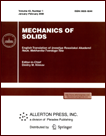 | | Mechanics of Solids
A Journal of Russian Academy of Sciences | | Founded
in January 1966
Issued 6 times a year
Print ISSN 0025-6544
Online ISSN 1934-7936 |
Archive of Issues
| Total articles in the database: | | 13362 |
| In Russian (Èçâ. ÐÀÍ. ÌÒÒ): | | 8178
|
| In English (Mech. Solids): | | 5184 |
|
| << Previous article | Volume 60, Issue 3 / 2025 | Next article >> |
| Tran Minh Luan, Minh Thi Tran, Tien Cuong Pham, Samir Khatir, and Thanh Cuong Le, "Evaluation of Kolmogorov-Arnold Networks in predicting bearing capacity of hollow circular and hollow square CFST columns," Mech. Solids. 60 (3), 1943-1955 (2025) |
| Year |
2025 |
Volume |
60 |
Number |
3 |
Pages |
1943-1955 |
| DOI |
10.1134/S0025654425600357 |
| Title |
Evaluation of Kolmogorov-Arnold Networks in predicting bearing capacity of hollow circular and hollow square CFST columns |
| Author(s) |
Tran Minh Luan (Center for Engineering Application and Technology Solutions, Ho Chi Minh City Open University, Ho Chi Minh City, Vietnam)
Minh Thi Tran (Faculty of Civil Engineering, Ho Chi Minh City University of Technology (HCMUT), Ho Chi Minh City, Vietnam;Vietnam National University Ho Chi Minh City (VNU-HCM), Ho Chi Minh City, Vietnam)
Tien Cuong Pham (The Institute of Civil Engineering, Ho Chi Minh City University of Transport, Ho Chi Minh City, Vietnam)
Samir Khatir (Center for Engineering Application and Technology Solutions, Ho Chi Minh City Open University, Ho Chi Minh City, Vietnam)
Thanh Cuong Le (Center for Engineering Application and Technology Solutions, Ho Chi Minh City Open University, Ho Chi Minh City, Vietnam, cuong.lt@ou.edu.vn) |
| Abstract |
In recent years, with the explosion of the industrial revolution 4.0, terms such as artificial intelligence (AI) have become familiar and increasingly widely applied in the engineering field. This study focuses on the study and evaluation of AI models to predict the axial strength of concrete-filled steel tube columns (CFST). In particular, this study introduces and highlights a new AI model, Kolmogorov-Arnold Networks (KAN), and compares its performance with the previously existing AI model, support vector regression (SVR), along with Eurocode 4. A large dataset consisting of two types of CFST columns (hollow circular and hollow square CFST columns) with different concrete strengths was created using ABAQUS software. The AI models were evaluated based on important statistical indices such as MAPE, MAE, RMSE, and correlation coefficient R. The analysis results showed that the KAN model was the most effective AI model when compared with other models. The R indices were always greater than 0.9 and the MAPE, MAE, RMSE indices were the lowest among the compared models. At the same time, the predicted data from the KAN model showed the highest similarity with the actual data in predicting the axial strength of four types of CFST columns. Therefore, the KAN model can be considered as a powerful and accurate tool in predicting the compressive strength of CFST columns. |
| Keywords |
Kolmogorov-Arnold Networks, concrete-filled steel tube column, support vector regression, machine learning, Eurocode 4 |
| Received |
21 January 2025 | Revised |
09 March 2025 | Accepted |
17 April 2025 |
| Link to Fulltext |
|
| << Previous article | Volume 60, Issue 3 / 2025 | Next article >> |
|
 If you find a misprint on a webpage, please help us correct it promptly - just highlight and press Ctrl+Enter If you find a misprint on a webpage, please help us correct it promptly - just highlight and press Ctrl+Enter
|
|

 Russian
Russian  English
English